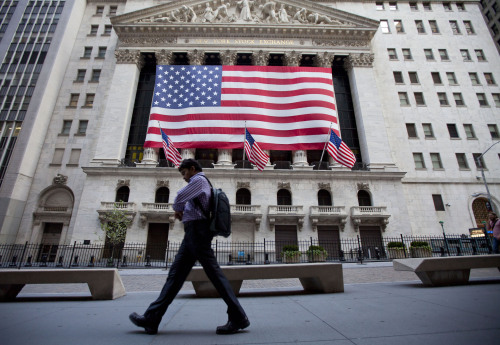WASHINGTON (AFP) ― Given the size of the U.S. economy and the preeminent role of the dollar worldwide, the cut to Washington’s credit rating ought to spill over throughout the global economy.
But for the same reason ― that the dollar and U.S. debt are so widely held and relied on in finance and trade ― many analysts think the impact will not be too heavy, at least in the short run.
Standard & Poor’s cut the U.S.’s top-rank “AAA” rating down a notch, to “AA+,” for the first time ever on Friday, technically signaling that the country’s reliability for paying its debts had decreased.
But for the same reason ― that the dollar and U.S. debt are so widely held and relied on in finance and trade ― many analysts think the impact will not be too heavy, at least in the short run.
Standard & Poor’s cut the U.S.’s top-rank “AAA” rating down a notch, to “AA+,” for the first time ever on Friday, technically signaling that the country’s reliability for paying its debts had decreased.

S&P rejected Washington’s efforts to demonstrate it had embarked on a clear path to slash the country’s deficit and reduce its debt load.
The debt burden topped $14.6 trillion last week, 100 percent of GDP, virtually the same ratio as Italy, whose debt has been dumped in markets over rising default fears.
Meanwhile the government continues to borrow some 40 cents for every dollar it spends, while the economy is barely growing and unable to generate the revenues needed to support its fiscal path.
The consequences of a downgrade are difficult to predict. Japan, cut twice in the past decade to stand at “AA” now, has a debt-to-GDP burden over more than 200 percent, but continues to pay extremely low rates to borrow.
Goldman Sachs warned last month in a study that the consequences of a downgrade were not easily foreseen.
“The size of the United States economy and Treasury market and the dollar’s status as a reserve currency make it impossible to find a clear historical parallel for the current situation,” the powerful investment bank ― itself a key dealer in Treasury bonds ― said.
Theoretically, the ratings cut should at least raise the borrowing costs of the government, to rates higher than “AAA” countries like Germany, and serve as a warning to get its fiscal house in order.
Moreover, it should push down the dollar’s value relative to other currencies from strong economies.
And because the dollar and Treasuries are so crucial ― China alone holds more than $1.1 trillion worth of U.S. debt and Japan, $900 billion ― any questioning of Washington’s ability to pay its debts should unnerve the global financial system.
“The recovery has lost momentum, the U.S. is up to its neck in debt and the Federal Reserve is considering more stimulus,” Kathy Lien of foreign exchange experts GFT said last week.
“If the U.S. loses its prized “AAA” rating, it will truly be the straw that broke the dollar’s back.”
“Different types of events have happened in history and we know to some extent how markets react to those events,” said Owen Fitzpatrick of Deutsche Bank.
“But here we never had a credit downgrade. It’s unchartered territory.”
But Goldman says the impact should not be large, and markets suggested the same ahead of the downgrade.
In the first place, it said, “A downgrade should not force sale of Treasuries.”
Indeed, with a possible downgrade looming, the price of Treasury bonds soared to their high this year on Thursday, the yield falling to its lowest level.
And the Treasury easily auctioned off tens of billions of dollars of new debt this week.
Goldman did say there could be a “modest” selloff in stock markets, and a sign of that was clear Friday when the Dow Jones Industrial Average suddenly plunged more than 400 points, or nearly three percent, after rumors of an imminent S&P move hit the market.
Even so, the market regained 300 of those points at closing despite the downgrade still hanging in the air.
In the banking market, where U.S. debt is a key currency for lending and collateral, the impact could be more disruptive.
That is especially true in the interbank “repo” market, where banks swap bonds for cash to balance their books short-term.
Goldman says the value of U.S. bonds in that market could fall by one percent after a downgrade, raising costs for banks.
Clearly hoping to mitigate the impact on financial institutions, the Treasury quickly issued a ruling Friday evening that said the risk weight of U.S. debt in their reserves would not change despite the downgrade.
But many expect the impact to be seen on institutions which rely on the U.S. government guarantee for their bonds, like heavily indebted home lenders Freddie Mac and Fannie Mae ― and the biggest banks which rely on the government’s implicit regulatory “too big to fail” guarantee.
Their borrowing costs could shoot up, and that would spill over into higher mortgage costs and possibly bank lending rates for the average person.
Meanwhile, liberal economist Paul Krugman, writing in the New York Times, questioned Standard & Poor’s ability to pass sound judgment on issues like countries’ sovereign debt ratings, saying “it’s hard to think of anyone less qualified to pass judgment on America than the rating agencies.”
“The people who rated subprime-backed securities are now declaring that they are the judges of fiscal policy? Really?,” asked Krugman, a Nobel Prize winner.


![[Exclusive] Korean military set to ban iPhones over 'security' concerns](http://res.heraldm.com/phpwas/restmb_idxmake.php?idx=644&simg=/content/image/2024/04/23/20240423050599_0.jpg&u=20240423183955)

![[Graphic News] 77% of young Koreans still financially dependent](http://res.heraldm.com/phpwas/restmb_idxmake.php?idx=644&simg=/content/image/2024/04/22/20240422050762_0.gif&u=)



![[Pressure points] Leggings in public: Fashion statement or social faux pas?](http://res.heraldm.com/phpwas/restmb_idxmake.php?idx=644&simg=/content/image/2024/04/23/20240423050669_0.jpg&u=)









